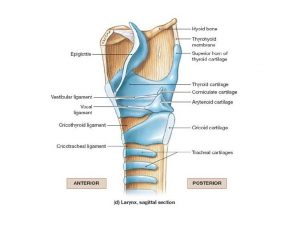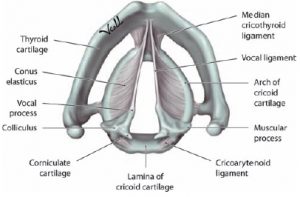What is the Corniculate Cartilage?
The corniculate cartilage is made up of elastic cartilage in our body. Elastic Cartilages, also known as Yellow cartilages in the human body are primarily composed of the protein Elastin. These cartilages are built up of collagen fibers and plastic fibrous networks. These are also known as cartilages of Santorini.
Where is the Corniculate Cartilage Located?
The Corniculate cartilage or the Cartilage of Santorini, which is also a yellow cartilage is found in the posterior portions of the aryepiglottic folds of the mucous membrane of the larynx. In some people with rare condition and structures of the cartilages, the corniculate cartilage may exist fused with the Arytenoid cartilages.
Corniculate Cartilage Structure
The Corniculate cartilages or the Cartilage of Santorini exist in the form of two modules which are in the form of two cones and these articulate with the peaks of Arytenoid cartilages. The Arytenoid cartilages are present in the shape of three-sided pyramidal structures which are attached to the larynx, which in turn is further attached to the vocal cords or vocal folds as a result of which they help in the movement of these vocal cords. Further, the corniculate cartilages provide longevity to the posteriorly and medially.
Corniculate Cartilage Function
The cartilage of Santorini or the Corniculate Cartilage helps by playing a role in the relaxing, tensing and approximating the vocal cords of the larynx due to which sounds generation is possible since it is attached to the Arytenoid cartilages which are further attached to the vocal cords. Apart from this function, the corniculate cartilage helps the larynx by allowing the opening and closing of Glottis, the portion of the larynx containing the vocal cords as well as the slit opening in between them, to help with the generation of sound.
Corniculate Cartilage Related Conditions
Few diseases or medical conditions which may affect the working of corniculate cartilage or the cartilage of Santorini. Some of them are as follows:
- Arytenoid Chondritis: Whenever ulceration or granulation took place on the superstructure of the Arytenoid Cartilage, an inflammatory response takes place. The thin fibrous tissue undergoes inflammation and in turn, affects the corniculate cartilage by creating a disturbing impact.
- Contact Granuloma: Also known as contact ulcer, this occurs on most portions of the Arytenoid cartilages, including the medial portions. This creates an extremely chronic pain which can be treated only by the definitive removal of that portion of the cartilage which is involved with the ulcers. The rest of the portion starts healing once the removal is done.
What are the adjacent tissues or organs of the corniculate cartilage?
The larynx, that portion of the human neck which is responsible for the production of sound, contains several cartilages, many small muscles, and a fibroblastic membrane. This fibroelastic membrane is simply a layer of elastic fibers and fibrous tissue. Within the larynx there exist three paired cartilages which are smaller in size as well as three cartilages larger in size and unpaired.
The large cartilages which are unpaired are:
- Cricoid cartilage
- Thyroid Cartilage
- Epiglottis
The smaller cartilages which are paired are:
- The arytenoid cartilages
- The Corniculate cartilage or the cartilage of Santorini
- the cuneiform cartilage
The cavities present in the larynx are:
- Laryngeal cavity
- Laryngeal ventricles and saccules
- Rima vestibuli and Rima glottidis
- Piriform recesses
Corniculate Cartilage Pictures




No comments yet.